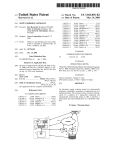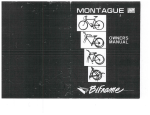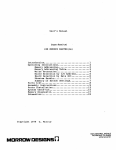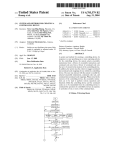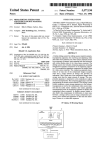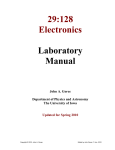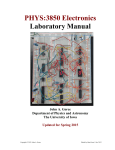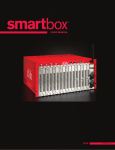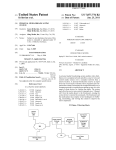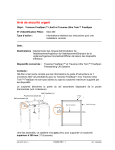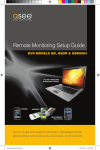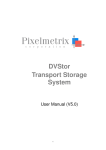Download F . ~%i“$5&8é&
Transcript
US008780199B2
(12) United States Patent
(10) Patent N0.:
(45) Date of Patent:
hdnnar
(54)
(56)
NETWORKED SECURITY CAMERA WITH
LOCAL STORAGE AND CONTINUOUS
RECORDING LOOP
U.S.C. 154(b) by 366 days.
This patent is subject to a terminal dis
claimer.
A1
A1
A1*
A1*
A1*
A1*
12/2001
6/2007
1/2008
8/2003
9/2006
1/2008
8/2008
8/2009
11/2009
2010/0139290 A1*
6/2010
(51)
.................. .. 434/11
174/50
348/371
348/2081
Leblond ......................... .. 62/33
* cited by examiner
(57)
Dec. 6, 2012
ABSTRACT
A networked surveillance audio-video recorder for security
applications with local storage and continuous record loop
using high-de?nition video and encrypted data is described.
Int. Cl.
Evidentiary audio-video is locally stored on a non-volatile
(2006.01)
storage media, and later transmitted in accordance with chan
US. Cl.
USPC ...... .. 348/143; 348/148; 348/151; 348/208.1;
348/208.3; 348/211.8
(58)
Goree et a1.
Baran et a1.
Primary Examiner * Yves Dalencourt
Prior Publication Data
H04N 9/47
(52)
Szolyga et a1.
Cho
Farneman
Wireless-G Internet Home Monitoring Camera, Cisco, Model:
WVC54GCA, pp. 1-2, California, USA, Jul. 2004.
QSD9004 User Manual, Q-See, p. 1-40,Feb. 2009, California, USA.
Sep. 20, 2009
US 2012/0307049 A1
2003/0156192
2006/0209187
2008/0020354
2008/0190639
2009/0207301
2009/0278945
MaZZilli
Monroe
OTHER PUBLICATIONS
(21) Appl. No.: 12/586,355
(65)
References Cited
6,333,759 B1
7,228,429 B2
7,319,485 B2
Subject to any disclaimer, the term of this
patent is extended or adjusted under 35
(22) Filed:
*Jul. 15, 2014
U.S. PATENT DOCUMENTS
(76) Inventor: Tibet Mimar, Morgan Hill, CA (US)
Notice:
US 8,780,199 B2
Field of Classi?cation Search
USPC ....... .. 348/143, 151, 153, 208.1, 208.3, 211.8
nel bandwidth with optional temporal, spatial or peak signal
to-noise ratio (PSNR) scalability and in accordance to display
capabilities of target viewing device upon request of time
regions of interest or window around alarm trigger events, or
for periodic archival reasons.
See application ?le for complete search history.
14 Claims, 11 Drawing Sheets
cues
mama
sawsOR
LENS
someone»:
cAmERA 18?
{SARREL &
sensor;
marrow
ADAPTSVE
SPATIAL ma
YEMPOML
FELTERiNG
F
.
FRONT~END
H.264
vmeo
come?zssson
COM9RESSK3N
.
'3
cmcuma
x
QUEUE
~%i“$5&8é&
STORAGE
US. Patent
Jul. 15, 2014
Sheet 1 0f 11
US 8,780,199 B2
= —
E CAMERA
E
T
H
E CAMERA
E CAMERA
ANALOG VIDEO
(60 FT CABLES)
_
SoC
E
'
PROCESSOR
Audioand
Video
R
N
E
Compression
i
= M
U
L
OO
I: CAMERA
T
T
'
|
'
A
S
|_
‘
L
X
HARD
Y
DISK
E CAMERA
TO
HLAN
II
=
i
5’
m'a
E CAMERA
=
—
V
POWER 5185
(D @ @
® @ G)
@
®
@
O
5* @
Prior Art Fig. 1
O
—>
MONITOR
US. Patent
Jul. 15, 2014
Sheet 2 0f 11
US 8,780,199 B2
CAMERA UNIT #1
OR
JPEG
_> 802.11
CAMERA
|/F
CAMERA UNIT #2
LAN
OR
JPEG
_, 802-111
CAMERA
l/F
D
9 CONTINUOUS
VIDEO STREAM
OVER LAN or WAN
CAMERA UNIT #9
LAN
MPEG
">
VF
H
OR
CAMERA
l/F
Prior Art Fig. 2
PC OR
LAPTOP
COMPUTER
US. Patent
Jul. 15, 2014
Sheet 3 0f 11
US 8,780,199 B2
FOWER
SU9?LY
A??
REGUMTGR$
110V AC
iNPUT
EXAM
Mama
CMQS
1 W
Hash
?ame
w
Sensor
& Lens
.‘
$6 1
a
.r,
3
a»
2:: m
a
‘7 Q
,1
800
,.
,_
Prucessor
g1 o
a.
£383
RECORD
auwom
REDIGREEN
sums
LED
1
REMOVABLE
NONNOLATiLE
’
smmez
i
LOCKJKEY ACCESS
Figure 3*
US. Patent
Jul. 15, 2014
Sheet 4 0f 11
US 8,780,199 B2
CJQOS
HQAGE
SEN$OR
tENS
CORRECIHQN
r CAMERA iSP
(BARRELa
GEFECT}
MGTiON
AQAP'TWE
8PAT¥A£ AND
TEMPORAL
FILYERENG
H.254
‘*
ViQEQ
QQMPRESSEG?
g
X
@_> FROMT~EhiB
Mam
mm}
CO?FRESEION
Figure 4
CiRCULAR
QUEUE
regifggigi?s
STOMGE
US. Patent
Jul. 15, 2014
Sheet 5 0f 11
US 8,780,199 B2
UNROLL THIS WAY
CURRENT
WRITE .._...>
POINTER
13>
"
Av
FILE
(PC FORMAT
COMPATIBLE)
Figure 5
US. Patent
Jul. 15, 2014
Sheet 6 0f 11
US 8,780,199 B2
SELECT
CIRCULAR
QUEUE
REQUESTED
‘ DATE aoTr1 T0 T2
‘
'
W'NDOW
AROUND
TRIGGER EVENT
ORIGINAL
COMPRESSED
DATA ,N HD
,
TRANSRATE
-—>
TRANSRATED
ORIGINAL
DATA
VIDEO
DECOMPRESSION
V
TEMPORAL/
SPATIAL
SCALING
V
VIDEO
COMPRESSION
Figure 6
TEMPORAL I
SPATIAL
SCALED
DATA
US. Patent
Jul. 15, 2014
Sheet 7 0f 11
US 8,780,199 B2
PQWER
118V AC M
"was?
suww
we:
REQULATQRS
DRAM
Fimh
Memory
Memory
CMOS
1
Sensor
7
& Lens
m
@,3*1" 5a:
SOC
1
Processor
g“ a
Q“
usa
802,11
AiBIGfN
W¥RELESS
iNTERFACE,
REMOVAQL£
nowamma
swam}:
Figure '7.
US. Patent
Jul. 15, 2014
Sheet 8 0f 11
US 8,780,199 B2
DRAM
Fias?
?emary
Mammy
CMOS
Samar
& Lem
1,
80C
@g gA
1"
1
Processor
r
2* 0
a,
USB
118V AC
PGWER
SUPPLY
{NPUT
AN!)
POWERMNE
'
iNYERFAQE
REGQLATQFZS
REMQVABLE
?QNNOiATiLE
STGRAGE
1W
AC
[Npu'f
M
PQWEWNE
WTERFACE
Mamwew P0 or LAPTOP
Figure 8.
US. Patent
Jul. 15, 2014
Sheet 9 0f 11
US 8,780,199 B2
RECHARGABkE
BAKERY
REGQLAYQRS
QRAM
Fiash
Mammy
Memory
1
1
cmos
Sensor
& Lens
4
“£261”, ,,
\wm >~
800
Processor
;
3G DATA
WkRELE’SS
{NTERFACE
REMOVABLE
NONNOLA'HLE
STORAGE
Figure 9.
US. Patent
Jul. 15, 2014
Sheet 10 0f 11
m
W2 3% iNCHESM
DEFTH m 3/2 inch
Figure 10,
US 8,780,199 B2
US. Patent
Jul. 15, 2014
Sheet 11 0f 11
LWtEW!
W2 iNCHESmw—F
{DEPTH m 3/2 inch
Figure 11.
US 8,780,199 B2
US 8,780,199 B2
1
2
NETWORKED SECURITY CAMERA WITH
LOCAL STORAGE AND CONTINUOUS
RECORDING LOOP
networks, thus causing unreliable operations and slowing
other network activity. Cabled systems using Ethernet
cabling also require di?icult cabling of multiple camera units.
Units con?gured to use 802.11 g systems contend bandwidth
collisions with other systems, cordless phone, wireless
BACKGROUND OF THE INVENTION
microwaves, and other wireless communication systems on a
limited number of channels. Thus, it becomes dif?cult and
unreliable to transfer plurality of live compressed video
stream in real-time without interruptions.
1. Field of the Invention
The invention relates generally to the ?eld of security and
speci?cally to the ?eld of audio-video security recording for
security purposes. More particularly, the present invention
relates to performing audio and video compression and stor
SUMMARY OF PRESENT INVENTION
ing data in a local storage that is networked.
The present invention provides a networked surveillance
2. Description of the Background Art
Existing security systems for homes and commercial prop
audio-video recorder system for security applications with
local storage and continuous record loop. The present inven
tion does not require continuous streaming of plurality of
erties feature multiple video camera connected to a security
box as shown in FIG. 1. The security box contains electronics
audio-video surveillance channel to a central unit, and does
not depend on a working network or phone interface at the
time of a trigger or intrusion occurrence. Evidentiary audio
video is locally stored on a non-volatile storage media, and
to convert analog video and optional audio inputs to digital
and performs audio and video compression by a System-On
Chip (SoC) processor, which then stores the results on a hard
disk. The system could be programmed for continuous
recording in a loop, recording upon a trigger caused by exter
20
nal alarm and scene change threshold, or timed scheduled
recording. The cameras are connected by cabling and video is
transmitted as analog to the main system. Such cabling makes
it dif?cult to install the multiple camera inside and outside a
later streamed in real-time upon request of time regions of
interest or window around trigger events, or for periodic
archival reasons. The present invention does not depend on a
local central storage from multiple camera unit that could be
easily removed by an intruder. Advanced H.264 video com
25
residence or commercial because of routing of such long
pression is used for video compression and for improved
video quality and reduced storage requirements. Video is
cabling between a user accessible box and cameras. Such a
stored at HD resolution, but transmitted for a given region of
system provides 240 frames-per-second capture, which is
interest to a remote location in requested resolution and video
divided by multiple cameras. For a 8-camera system, each
camera video is captured at 240/8, or 30 fps, but capture
resolution is usually low at CIF resolution (350x240). Such a
security box can display captured video live from cameras or
rate.
30
BRIEF DESCRIPTION OF DRAWINGS
from hard disk on a monitor or TV, and user functions are
The accompanying drawings, which are incorporated and
controlled by front-panel buttons or an infrared remote-con
trol unit (RCU). This means such a security box must be
located near a TV and be visible for RCU operation. Such a
system also provides means for remote viewing over intemet,
and can also send email messages with some snap shots of
video when a alarm trigger occurs. However, there are many
vulnerabilities in such a system. If intemet is not working at
the time of intrusion because phone or intemet cables are
externally cut, then no such email could be send. Thief can
form a part of this speci?cation, illustrate prior art and
35
security system.
FIG. 2 shows block diagram of a prior art of a second prior
40
45
security based where multiple camera units are connected to
present invention.
FIG. 5 shows circular queue for continuous recording loop
of audio and video.
FIG. 6 shows block diagram of possible options for send
a PC or laptop computer over local area network or wide-area
network, as shown in FIG. 2. For example, 9 wireless camera
units can connect to a PC computer using Ethernet wires or
802.11 wireless communication. Each camera unit contains
art security system.
FIG. 3 shows block diagram of one embodiment of present
invention.
FIG. 4 shows block diagram of data ?ow and processing in
easily remove or damage the whole security box which
removes all security data.
Another existing video security systems use networked
embodiments of the invention, and together with the descrip
tion, serve to explain the principles of the invention.
FIG. 1 shows detailed block diagram of a ?rst prior art
ing video surveillance data to a remote monitoring site.
FIG. 7 shows block diagram of second embodiment of
50
video camera, video compression, and network interface in
present invention using wireless networking.
FIG. 8 shows block diagram of third embodiment of
present invention using power line networking.
this case. Existing systems use I PEG or MPEG-2 or MPEG-4
systems, but in the future this will probably extend to
FIG. 9 shows block diagram of third embodiment of
advanced H.264 video compression standard as well in new
present invention using solar cell for charging embedded
designs. If there is no local computer, it is also possible to
55
rechargeable battery and 3G or 4G wireless modem for net
connect the cameras to a router connected to a WAN gateway,
working.
so that multiple security video channels could be streamed to
FIG. 10 shows illustration of audio-video security module
physical characteristics in one embodiment.
FIG. 11 shows illustration of audio-video security module
physical characteristics in an embodiment using micro SD
card for local storage of surveillance recording in a continu
ous loop.
a remote PC or laptop. The remote PC or laptop could perform
remote viewing or recording of one or multiple channels on
its hard disk storage. One of the disadvantage of such a
security system is that if internet access deliberately inter
rupted at the time of a security event, then it is not possible to
stream the data for the event to the remote PC for recording.
If the PC is located locally, then it could easily be removed by
the perpetrators. Furthermore, such a system requires con
tinuous stream of multiple video streams over local and wide
area networks, which places a considerably load on such
60
DETAILED DESCRIPTION
65
In today’s world, there is a strong need for video security
systems that are easy to install, to perform continuous video
US 8,780,199 B2
3
4
recording, and storage of security video without depending
Using wide-angle lenses causes a barrel effect. Such lens
defects are removed in real-time by front-end processing.
upon external or local network or phone connections at the
time of an emergency, and without the risk of stored video
Motion adaptive spatial ?ltering compares each pixel of a
data being removed by perpetrators. In today’s technology
powerful System-on-Chip (SoC) contain all system functions
given frame with same pixel from the last frame of video, and
in a programmable manner on a single chip that is smaller
than a half inch on each side, yet being able to process com
bined with weights of x and (1-x), respectively, in accordance
with difference said current and last frame pixel values. This
has the effect of ?ltering high motion areas, since human
?ltered new video frame and un?ltered video frame are com
plex audio and video processing tasks, and system interfaces,
beginning to compete with PC processors by performing and
providing multiple processors and multiple hardware accel
visual system are less sensitive to noticing the resolution of
such areas. Motion adaptive temporal reduces the video noise
when there is no motion without reducing the video resolu
network interfaces, etc all on a single chip. Such SoCs are
erators on a single chip, but at much lower cost, size and
tion. Two or more video frames are averaged on a pixel-by
power consumption points. At the same time, the emergence
of advanced video processing techniques and advanced video
compression standards such as H.264 enable high-quality
pixel basis, in other words depending on the region of a video
frame, in accordance with a IIR ?lter to reduce temporal
noise. The resultant effect of motion adaptive spatial and
compressed video streams at a 3-4>< reduced bit stream rates.
temporal ?ltering prior to video compression is to signi?
These capabilities provide means for advanced processing
and storage at each security node without having to stream
cantly further increase the video compression and/ or increase
20
video quality.
The output of motion adaptive spatial and temporal ?lter is
compressed using the advanced video compression standard
a removable non-volatile semiconductor storage such as USB
H.264. H.264 provides high video quality and at the same
memory key to continuously record audio and video in a
forever loop on said USB memory key or other type of Flash
25
time reduces the amount of data that is necessary to store by
a factor of 3-4 in relative to MPEG-2 standard. This allows
storage of data on a USB memory key at high quality without
requiring the use of hard disk storage. Hard disk storage used
multiple streams of low quality data at each camera site. The
present invention uses a System-on-Chip (SoC) connected to
non-volatile memory, where each loop is completed in mul
tiple days or more in accordance to size of USB memory key
used. This is different than existing security systems because
video is recorded in high quality of standard de?nition (640x
by existing systems increases cost and physical size. SoC also
performs audio compression, and multiplexes the com
480) with image sensor, image processing and storage of
pressed audio and video together. The multiplex compressed
surveillance data collocated at the camera site without having
to stream data continuously over cabling or wireless in real
time. Also advanced image processing, and video compres
sion is used for high-quality video image up to 720P HD
resolution in comparison to today’s CIF resolution security
cameras at less than 30 fps resolutionusing MPEG-2, MPEG
4.2, or motion JPEG with lower quality. If there is security
event, past audio-video data for the last couple of days could
30
the output of multiplexer for standard de?nition video at 30
frames-per-second, we have 5.5 Gigabytes of storage
required per day of storage. Using a 16 Gigabyte USB
memory key could store about three days of storage, and 64
35
Gigabyte USB memory key can store about 11 days of stor
40
age.
Since the compressed audio-video data is stored in a cir
cular queue with a linked list pointed by a write pointed as
shown in FIG. 5, the circular queue has to be unrolled and put
in a ?le format recognizable as one of commonly used PC
be examined. Since the present invention does not use a hard
disk, and just a small USB memory key is used in one embodi
ment in conjunction with advanced H.264 video compres
sion, physically a very small audio-video monitoring security
audio-video is stored on part of USB memory key in a con
tinuous loop as shown in FIG. 5. At a typical 500 Kbits/ sec at
module could be easily placed discreetly in multiple places
audio-video ?le formats. This could be done, when recording
without attracting attention and require only external power
is stopped by pressing the record key by doing post process
in some embodiments. The lack of central storage prevents
ing by the SoC prior to removal of USB key. Such a conver
sion could be done quickly and during this time status indi
cator LED could ?ash indicating wait is necessary before
the central storage unit being stolen, and a dummy central
storage unit could be optionally used to provide the appear
45
ance of damaged or removed evidence of stored video sur
USB memory key removal. Alternatively, this step could be
veillance data.
In one embodiment shown in FIG. 3, the only connection
required is the power connection to a 110V AC, and such a
performed on a PC, but this would require installing a pro
small security module could be directly plugged in a power
gram for this function on the PC ?rst.
50
outlet, or mounted near a light ?xture to receive power. The
small memory key, record button, and status indicator is
placed under a small keyed cover to prevent stopping or
removing the USB memory key by an unauthorized access. In
this embodiment, USB memory key can be removed and
55
plugged in a PC or laptop for accessing the stored video loop.
encrypted so that only people with security key can access the
stored surveillance video and audio data.
60
camera Image Signal Processing (ISP) function as part of the
Since images from a CMOS sensor does not have issues of
be obtained.
transrating or temporal or spatial scaling. Transrating
requires partial decode of the desired region up to quantiza
tion step and changing quantization and performing variable
length encode again with the new quantization factor.
The original data is stored as a variable bit rate (VBR) in the
circular queue since there is no limitation for bit rate peaks for
local storage, but this could be changed to constant bit rate
camera module or the SoC. ISP performs auto white balance,
auto-gain, Bayer conversion, lens defect correction, etc.
interlaced video input, the resultant video is much higher
quality, and resolution up to and including 720P could easily
device. For example, if the data is to be sent over a 3G or 4G
network to a remote personal media player at SD resolution,
but recorded data is at 720P resolution, this requires either
Optionally, the stored data on USB memory key can be
FIG. 4 shows that CMOS image sensor interfaced to a
In networked embodiment of the present invention, remote
site could request data for a given date and from time T1 to
time T2. Such requested data could be sent directly from
compressed data in circular queue, as shown in FIG. 6. Alter
natively, stored data could be transrated to match the capa
bilities of network channel and/ or the destination display
65
(CBR) stream by the transrating for transmitting over a low
bandwidth network channel with no ability to handle peak
rates of VBR.
US 8,780,199 B2
6
5
camera module. Transrating helps matching the destination
device and channel bandwidth capabilities, but data could
also be transmitted in non-real-time, and displayed after
The requested data could also be sent in a data ?le format
without the need to real-time streaming since it is already
stored in local storage of the camera module. Thus, there is no
requirement to stream it in real-time. Transmitting the
transfer.
Present invention also provides for data for a desired win
dow to be sent with PSNR or temporal scalability so that ?rst
a quick search could be performed for the region around an
time of interest such as a alarm trigger point, and fast forward
type search could be done. Then, as a second step a higher
resolution version, or further layers of PSNR scalable reso
requested window of data as a data ?le provides a convenient
means to get the data by a remote site over a low bandwidth or
unreliable network channel. The data could be sent with TCP/
IP so that any errors are recovered by re-request of those
portions.
In contrast, prior art systems with multiple camera systems
reliably accomplished due to high-demand of multiple video
lution could be requested around the region of interest.
The present invention provides scalable video quality since
have to stream multiple channels of data which cannot be
streams over a local area wireless network. If only one stream
video data could be captured at HD (based on a setup com
from one selected camera is streamed, then data from other
cameras are permanently lost. If the cameras are wired, there
mand remotely), and then scaled spatially and transrated at
the time of transmit request in accordance with channel and
is still the problem of streaming multiple channels due to
destination capabilities.
limited uplink rate of intemet accesses. Again, either all data
is stored in a central location which is subject to removal, or
some channels of data is permanently lost.
FIG. 7 shows an embodiment where removing the USB
memory key is not necessary, and access to past surveillance
data is transferred using a 802.11 a/b/g/n wireless standard
The audio-video that is streamed upon request is encrypted
using 802.11 WEP or other method to prevent viewing by
other people, and it is not normally streamed all the time,
there is more security against unauthorized access of security
20
video externally.
Since the surveillance data is stored locally in a small
unsuspecting and hard to notice physical module, there is
signi?cantly less risk of removal of such storage information
interface that is built in to the camera interface. In this case,
the audio-video data is not continuously streamed over wire
less interface, but it is continuously stored onto local embed
25
as in the case of central video surveillance that is accessible
ded USB memory key. A remote user can connect to a given
and removable of prior art systems.
camera module of present invention and request transfer of
Another embodiment of present invention uses power line
interface to transfer the surveillance data upon request by a
surveillance data starting from a time T1 to time T2 on a
speci?ed date which is within the window of continuous loop
of recording. Such requested data is transferred while at the
local or remote PC, as shown in FIG. 7. There are several
30
same time continuing to record. The data transfer in this case
does not have to be in real-time because the source data is
already stored, and thus it could be done over networks with
less bandwidth than the recording bandwidth of camera mod
ule. The following remote commands could be executed by
additional cabling. In this case, the power supply connection
is used to communicate one or more camera modules to a
35
the camera module:
Status: Provides current status: recording, stopped, start of
times motion detected, etc.
Mode: Resolution requested or layer of PSNR scalable data to
be sent for desired range.
40
Stop: Stop recording;
Stream Video Clip: Sends from T1 to T2 for a speci?c date.
This could be done in real-time, or as a ?le-transfer in
45
provides the capability of transmitting regions of interest of
previously recorded audio -video data with temporal or spatial
scalability in accordance to available network channel band
width and/ or target device display capability. For example, if
50
55
real-time, since captured data is already stored in high-reso
lution on local storage at the camera location as part of the
look at plurality of incoming video streams in a video moni
toring room, only certain cameras are watched, and previ
ously recorded portions of surveillance could be transferred
upon request. Furthermore, since processing is done at the
camera module, it is easy to add video facial recognition for
certain list of individuals in public places for certain action to
FIG. 9 shows the physical size of present invention in one
embodiment using a USB memory key. The BOM cost of
such a system is less than $50, thus such a system could be
commercial and residential applications. FIG. 10 shows a
physical size of present invention using micro SD card for
storage.
60
requested by the central device. The central device could be
monitoring station or a cell phone with video playback capa
bilities and could be physically located on the premises or
anywhere else with Internet or phone access. The present
invention does not depend on network to stream the data in
fer interface. This embodiment requires no cabling. Applica
tion of this is not only residences, and commercial properties,
but also traf?c light and street comers, and other public
places. Instead of cabling multiple cameras and having to
sold at about $99, and be deployed widely at public places,
to as transrating). The present invention also provides ability
to temporarily scale compressed data for remote fast forward
and search capability, and once a desired region of interest is
located, then higher resolution video of the same could be
Another embodiment of present invention uses a solar cell
and rechargeable battery, and a 3G or 4G data wireless trans
be signaled.
the target device requesting data is a mobile networked per
sonal media player (or cell phone with such display capabil
ity), then compressed video data is partially decompressed
and then compressed again at the display resolution (referred
power line module connected to a router that is connected to
a local PC or intemet. As in the 802.11 interface, commands
could be issued over the power line interface to control each
camera module and to access certain audio-video clips as
desired within the time window of past cyclic storage, and
video data is only streamed when requested.
Record: Start recording mode;
non-real-time depending upon the connection and avail
able bandwidth.
The local storage of surveillance data and the ability to
transrating the stored data by the SoC of present invention
power line interface standards such as HomePlug AV which
transfers data over existing power lines without requiring
I claim:
1. An apparatus for video surveillance system, the appara
tus comprising:
at least one camera sensor, said at least one camera sensor
65
is con?gured to capture 30 frames-per-second at a mini
mum of high de?nition resolution;
at least one image signal processor coupled to said at least
one camera sensor for performing image signal process
US 8,780,199 B2
8
7
ing functions including but not limited to auto white
2. The apparatus according to claim 1, further comprising:
balance, auto gain, wide-angle lens barrel distortion
reduction, and lens defect compensation;
a motion adaptive spatial and temporal ?ltering unit that is
a microphone, an audio preampli?er, an audio-to-digital
conversion circuit, and an audio compression unit; and
a multiplexer to combine output of said audio compression
unit and said at least one video compression unit.
3. The apparatus according to claim 1, wherein said remov
coupled to output of said at least one image signal pro
cessor for preprocessing of video data;
at least one video compression unit according to H.264
standard that is coupled to output of said motion adap
tive spatial and temporal ?ltering unit, said at least one
video compression unit is con?gured to compress 30
able non-volatile semiconductor storage media uses ?ash
memory including but not limited to a USB memory key, a
SDHC memory card, a micro SD card.
frames -per- second at a minimum of high de?nition reso
4. The apparatus according to claim 1, further including a
rechargeable battery to power the apparatus, and a solar cell to
lution in variable bit rate;
recharge said rechargeable battery.
5. The apparatus according to claim 1, wherein said inter
net interface unit uses HomePlug AV standard using power
a processor coupled to at least one video compression unit
to store compressed data on a removable non-volatile
semiconductor storage media in a continuous record
lines to connect to a local or remote device for transmission of
ured for storing multiple days of storage of surveillance
data when requested.
6. An apparatus for security and evidentiary recording, the
data, in accordance with size of said removable non
apparatus comprising:
loop in a circular queue, said circular queue is con?g
volatile semiconductor storage media, before oldest data
a camera image sensor with at least high de?nition resolu
is overwritten by newly recorded video;
tion for capturing video at 30 frames per second;
an audio microphone;
a removable ?ash memory including but not limited to
USB memory key, SD memory card, or micro SD
an encryption unit coupled to said processor, wherein said
stored compressed data on said removable non-volatile
semiconductor storage media is con?gured to be
encrypted to allow only people with a security key to
access said stored surveillance data;
an internet interface unit coupled to said processor using an
interface including but not limited to 802.11 wireless
interface, 3G data interface, 4G data interface, or a
25
a system-on-a-chip processor coupled to said removable
?ash memory and said camera image sensor, said sys
tem-on-a-chip processor comprising:
power-line data interface;
a transrating unit coupled to said removable non-volatile
semiconductor storage media using said lntemet inter
face unit for transmitting said stored surveillance data at
a camera ISP;
30
a hardware unit for lens barrel distortion reduction and
lens defect compensation;
a ?rst hardware accelerator module for motion adaptive
spatial and temporal ?ltering;
a different constant bit rate (CBR) in accordance with
transmit channel and destination capabilities;
wherein said surveillance data from said circular queue for
memory card;
a rechargeable battery;
a second hardware video accelerator unit for H.264
35
a time of interest from a start time to an end time is sent
video compression at 30 frames-per-second with vari
able bit rate (VBR);
by said processor upon request by a remote device com
municating to said Internet interface unit using a H.264
a hardware accelerator for transrating a VBR stream to a
compressed and encrypted audio-video data ?le format;
available network channel bandwidth and target
wherein, in case of a trigger event, data enveloping said
different bit rate CBR stream in accordance with
40
device display capability;
trigger event is saved and transrated into a lower con
stant bit rate before encryption and transmittal to one or
a security processor for encryption or decryption of
more prede?ned internet destinations;
a processor unit for audio compression;
an audio and video multiplexing circuit;
wherein, upon request to transmit a time range of said start
time to a stop time, requested data is transmitted in a data
locally stored and transmitted data;
45
wherein compressed, encrypted and multiplexed audio
?le format in non-real-time using TCP/ IP protocol, said
video surveillance data are stored on said removable
data ?le is generated by decompressing video, perform
ing temporal and spatial scaling, and compressing video
?ash memory using a circular queue, said circular
at a different data rate in accordance with request and
recording;
capabilities of a receiving device;
queue is con?gured for storing at least several days of
50
wherein all elements of the apparatus are integrated into a
single compact unit:
whereby the apparatus is con?gured to save evidentiary
data locally in said removable non-volatile storage
media;
55
whereby an intruder is prevented from removing said evi
dentiary data that is captured and stored on multiple
distributed units of the apparatus which are hard to reach
60
for signaling a trigger event to said remote device;
wherein, upon request to transmit said time range of said
start time to said stop time, requested data is transmitted
in a data ?le format in non-real-time using TCP/ 1P pro
65
video, performing temporal and spatial scaling, and
cated at the apparatus without having to stream data
continuously over cabling or wireless in real-time,
thereby power consumption and local bandwidth of
tocol, said data ?le is generated by decompressing
transmitted data are signi?cantly reduced because con
tinuous streaming of data is not required; only said data
an lntemet interface coupled to said system-on-a-chip pro
cessor including but not limited to 802.1 1 wireless inter
face, 3G wireless data interface, 4G wireless interface,
and a power-line networking interface, said intemet
interface is active only for sending data for said start time
to said stop time upon request by said remote device and
or remove; and
image processing and storage of surveillance data collo
wherein a time range from a start time to a stop time of
surveillance data is transmitted to a remote device
upon request by said remote device or upon occur
rence of a trigger event;
enveloping said trigger event or a requested time zone is
compressing video at a different data rate in accordance
transmitted upon request by said remote device.
with request and capabilities of a receiving device;
US 8,780,199 B2
10
wherein said trigger event including but not limited to
9. The apparatus according to claim 6, wherein said remov
motion detection, causes copying data enveloping said
able ?ash memory is con?gured to be unplugged and plugged
trigger event to a separate ?le in said removable ?ash
memory, and sending said copied data as an attachment
to a prede?ned email address;
into a PC or a TV for viewing said video surveillance data.
wherein all elements of said apparatus are tightly packed in
a single small enclosure; and
whereby one or more units of the apparatus concurrently
10. The apparatus according to claim 6, wherein contents
of said removable ?ash memory are encrypted so that only
people with security key is provided access to view said video
surveillance data.
11. The apparatus according to claim 6, wherein data is
captured and stored with variable bit rate in said circular
capture video surveillance data continuously and store
said video surveillance data locally for at least several
days of past history and ensure that all evidentiary data
queue, and is converted to a constant bit rate stream to trans
mit over a low-bandwidth network channel upon request.
are captured and analyzed when occurrence of an event
is detected at a later time.
remote device is one of a personal computer, a cell phone, or
7. The apparatus according to claim 6, wherein said power
line networking interface uses HomePlug AV standard.
8. The apparatus according to claim 6, wherein the appa
ratus is packaged in a compact enclosure which is less than 2
inches by 21/2 inches in size and directly plugged into a power
outlet.
12. The apparatus according to claim 6, wherein said
a monitoring station,
13. The apparatus according to claim 6, wherein the appa
ratus also performs facial detection and triggers a certain
action for a certain list of individuals.
14. The apparatus according to claim 6, wherein an elec
tronic bill of material cost is less than $75.
*
*
*
*
*

















